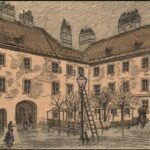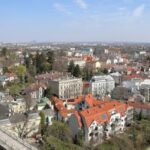In our series, after the Schwarzspanierhaus, we cover another important and famous residence of Beethoven, the Pasqualati House.
The history of the Pasqualati House
Originally, the house was two different buildings and the first written document to list the place is from the 18th century. One building was owned by an imperial captain and engineer, Leander Anguissola. After him, in 1746, imperial councilor Johann Jakob von Marinoni purchased the building. He was an astronomer and court mathematician, also a teacher of astronomy to Empress Maria Theresa.
In 1786 a new owner showed up, who combined the two buildings into one. His name was Dr. Johann Benedikt Pasqualati von Osterberg, the personal physician to Empress Maria Theresa (mother of Marie Antoinette). The construction works were finished in 1791.
The building was situated next to and above a protective city wall (bastion or bastei) that stood until 1850. This fortification defended the city for centuries, the part which is now the inner city. It was demolished to make way to The Ring, a boulevard that surrounds the old city today.
In 1799 the doctor passed away and his children (two sons, three daughters) inherited the property. The eldest son managed and occupied the building, Baron Johann Baptiste von Pasqualati of Osterberg (2 March 1777 – 30 April 1830). He was an official agent of the Imperial Court and a wealthy merchant.
The building was (and even today is) very impressive. Its original address was Nr.1239 Mölkerbastei, that is Mölkerbastei 8. today. Beethoven occupied the top floor apartment that had five rooms and was overlooking the Glacis (gla-see), a meadow that surrounded the area and most of the city. He could also see the Vienna woods (Wienerwald), and the Leopoldsberg and Kahlenberg peaks. It is safe to say, the apartment was comparable to what is today an apartment overlooking the Central Park in New York.
Beethoven and Pasqualati
Lucky for Beethoven, the younger Pasqualati was not only influential and wealthy, but also a lover of music. He himself played the piano and tried his hands at composing. As such, he was a great admirer of Beethoven and his music.
His connection to Pasqualati started with a letter Beethoven wrote in July 1804 to his pupil and friend Ferdinand Ries. In this he said, that he would like to have a better, quiet place for himself in the city. Ries soon had found the perfect place for him, as he put in his memoir, “I then chose – on the Mölkerbastei in the ‘Pasqualattischen house’ – a flat on the top floor, with a nice view…”
It is worth mentioning that Beethoven, with this apartment included, in this period had four places at the same time: two summer flats and two in Vienna, the Pasqualati House and at the Theater an der Wien.
It is safe to say that Beethoven and Pasqualati became friends. The landlord was always patient and had the foresight not to rent the place to others, even when Beethoven (often) moved out. The composer lived in this apartment – with interruptions – from 1804 to 1815. Among the many places he lived parallel, this one is to be considered more permanent than others. He even tried to modify the apartment, to open a window on a wall to provide view on the Prater, something Pasqualati did not know about, just in the last minute to stop undermining the building’s structural integrity…
Testament to the care and friendship between the two is the letter Beethoven dictated in his final days, in his deathbed. He thanked Pasqualati for the food and champagne he had sent to him,
“How can I thank you sufficiently for that excellent champagne which has so greatly refreshed me and will continue to! I need nothing more for today and I thank you for everything.—Please note down what further result you achieve in respect of the wines, for I would gladly compensate you as much as my strength allows.—I cannot write any more today. May Heaven bless you in every way and reward you for your affectionate sympathy with your respectful and suffering BEETHOVEN”
In 1941, in a room on the fourth floor, a Beethoven Museum was opened. This museum is still one of the most important Beethoven sites in Vienna.






